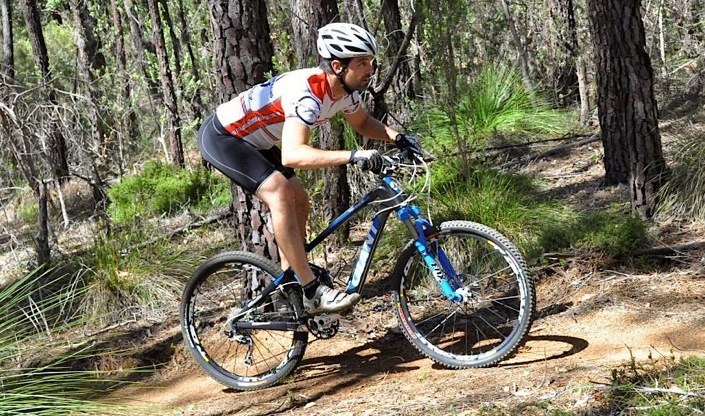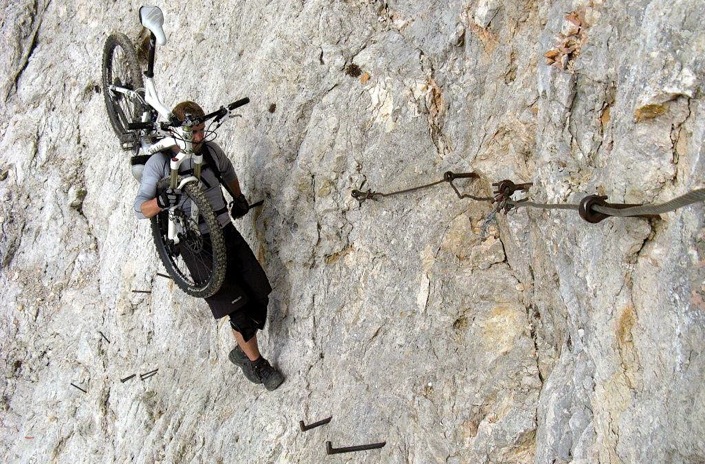
In our first mountain bike climbing article we looked at attitude and getting yourself setup prior to beginning a climb. Now we are going to look into different terrain and how to ride it!
Long steady climbs
The key to long steady climbs is to ride comfortably within your own zone. There are a few ways to accomplish this, the intention being to arrive at the top without having to gasp for breath in exhaustion!
- Position yourself on the saddle so you are balanced between the front and rear wheel. Try to relax your upper body, shoulders, neck and arms, and keep a firm but not strangling grip on the bars. (In this position you should actually be able to climb while having a very loose handlebar grip).
- Regulate your breathing. On a long climb a good marker is being able to carry on a conversation while pedalling - this way you know you're not working yourself too hard.
- Sit more upright than you would when the road gets steep. This opens out your chest and diaphragm allowing maximum lung capacity to be used.
- When mountain biking, long climbs can actually be a place to recover from the intense peaks and troughs your heart rate goes through from riding typical undulating trails. Take it easy and recover!

Short steep climbs
Let's face it, steep climbs are more frequent (unfortunately) than long steady ones when riding singletrack. The biggest challenge is keeping your tire in traction with the ground while trying to put down power. To accomplish this you have to be able to shift your weight, and therefore your centre of balance/gravity, between the front and rear end of your bike.
- Move your body forward slightly on the saddle. This sets you up for any weight shifting when you hit those really steep pinches.
- Standing up on the pedals shifts your weight away from the back wheel which may result in total loss of traction. It is a better practice to drop your chest close to the bars which puts more weight on the front wheel while still allowing you to use your body weight to keep up grip on the rear.
- Gearing depends on the length of the climb. A bigger gear may work on shorter climbs as you can rely on momentum, but the danger is running out of juice half-way. Lower gears allow you to spin, which saves energy, although high cadence pedalling can unbalance you on steep, or technical sections. The key to either technique is keeping tire grip and preventing wheel spin.

TIP: Just because it's a big gear doesn't mean you have to mash the pedals in a panic. Try to regulate your torque evenly and feel the tires gripping underneath you. It is very similar to a car. Ever tried cornering at speed in a car while coasting? Now try that same corner while applying power. The car sits down, grips up and you exit the corner with speed and control. The same goes for mountain biking. Big gears help the bike behave, creates better control and grip and helps get your power down.
Rocks, logs and other obstacles

Photo: BFD / singletracks.com
You're on a singletrack climb, pedalling close to your limit, then up comes a rocky section or a log across the trail... Are you able to kick over it, or is it time to walk?
- Ride as big a gear as you can manage and avoid slipping down into granny. These types of climbing obstacles require an explosive "kick", firstly to lift the front wheel and then to power forward.
- Riding in low gears, and particularly in a 22t can destabilize you and makes it difficult to shift weight and balance. It also makes it difficult to get immediate power down.
- To lift the front wheel while climbing takes some practice but can be achieved easily by shifting your weight back while applying a decent kick on the pedals. Don't use your arms to pull back on the bars - they should remain fairly straight as you shift your weight backwards.
- Once the front wheel is on top of, or over the obstacle, shift your weight forward again while standing on the pedals and use the combination of momentum and a careful application of power to guide the rear wheel over as well.
This is an important skill to master as it opens up all types of climbing skills, increases confidence and enhances your ability to balance.
Gravel and loose surfaces
Once again, it is all about maintaining traction.
- Again, avoid really low gears... You just end up slipping and skidding and going nowhere. Find a gear that allows decent power but minimises the tendency for wheel spin. I prefer a big gear here as well.
- The trick is to balance weight between the front and rear tires. The rear so you can apply power and the front so you can remain in control and so the wheel doesn't go wandering.
- A good method is to stay in the saddle but with chest lowered near the handlebars. This position allows you to maintain a low centre of balance. Avoid standing up pedalling as you will just get tire slip.
Hopefully these tips will help you become a better climber. The only other requirement is a healthy set of lungs. Good luck!


